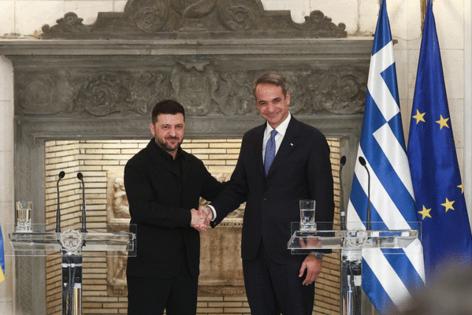Russia and Ukraine escalate energy wars with peace talks looming
Published in News & Features
Russia and Ukraine are fighting an increasingly intense energy war as they attempt to gain a meaningful advantage after months of stalemate on the front-lines and ahead of potential new peace talks.
Massive Russian attacks on Ukraine’s energy infrastructure are leaving businesses and households wrestling with lengthy power outages, as Moscow looks to weaken morale and inflict more economic damage with the harsh winter months approaching.
Ukraine is hitting back with strikes targeting Russia’s energy infrastructure, from refineries to sea terminals, aiming to interrupt the flow of petrodollars to the Kremlin’s coffers and strain its ability to finance the war.
“Russia will do everything it can to ensure we have constant blackouts,” Ukrainian President Volodymyr Zelenskyy told Bloomberg News in an interview. “But they should know that we will respond. I think it’s fair.”
The air exchanges are unfolding as the two sides seek to put themselves in the most favorable position ahead of potential negotiations for an end to the war that’s deep into its fourth year. Donald Trump made a renewed push for a resolution on Thursday when officials presented a 28-point peace plan drawn up in consultation with Russia that Zelenskyy said he’s willing to work on with the U.S. president.
The plan would force Kyiv to cede large chunks of territory taken by Russia, cap the size of its military and lift sanctions on Moscow over time. It would also tap Russian frozen assets to help pay for Ukraine’s reconstruction and the U.S. would work with Kyiv to restore the country’s gas infrastructure.
Ukrainian grid operator Ukrenergo said Thursday that emergency power cuts were in place in most regions of the country as crews worked to repair damage from Russian strikes on energy facilities and restore supply.
Ukraine has faced repeated Russian attempts to break its resistance by targeting energy assets in winter, when temperatures routinely plunge far below freezing and the battlefield is largely static for months as a result of snow and ice.
The accumulated damage to power grids and generating plants along with the current scale of Russian strikes are putting Ukraine’s energy infrastructure under increasing strain, despite efforts to swiftly restore services.
This winter “could be the harshest” since Russia’s full-scale invasion began in 2022, according to Maxim Timchenko, chief executive officer of DTEK, Ukraine’s largest private energy company. “Since September, Russia has been hitting every kind of energy asset — mines, power stations, substations, power lines, gas production and gas storage.”
A Russian attack involving more than 500 drones and missiles on Wednesday killed at least 25 people and triggered fresh power outages. Last week alone, according to Zelenskyy, Russia fired more than 2,000 attack drones, glide bombs and missiles at Ukraine.
While officials decline to disclose the extent of the damage, the duration of power cuts offers one indication. Electricity outages in Kyiv have lasted for an average of eight hours in recent days, reaching as much as 16 hours on some occasions, according to DTEK data.
Ukraine has claimed attacks on about 45 Russian fuel-production facilities since early August, bringing the total to around 65 so far this year, with strikes on refineries pushing oil-processing volumes below the seasonal norm. That compares with 35 attacks last year, according to public statements and data compiled by Bloomberg.
Ukraine hit Russia’s Black Sea oil-loading infrastructure on Nov. 14, triggering a state of emergency and briefly disrupting crude loadings for export.
The attacks have stepped up as Kyiv’s western allies have expanded sanctions to squeeze Russian revenues from energy sales on global markets.
“We need to do more so that this war will stop and it will stop when Russia runs out of money and understands they can’t outlast us,” European Union foreign policy chief Kaja Kallas said Tuesday at a Bloomberg event in Brussels.
Ukraine has produced its own long-range missiles that allow it to strike more deeply into Russia, and is also gaining encouragement to attack energy facilities from allies that were previously reluctant to support such a strategy, fearful of an effect on global oil prices.
The U.K. recently resupplied Ukraine with its Storm Shadow cruise missiles. Ukraine said Tuesday that its forces used U.S.-made ATACMS supersonic missiles to strike military targets in Russia. The Defense Ministry in Moscow said its air defenses shot down four ATACMS over Russia’s Voronezh region.
Kyiv’s development of its own long-range capabilities “has eroded what started as a near-total Russian advantage” in attacks on the energy sector, said Eric Ciaramella, senior fellow at the Carnegie Endowment for International Peace in Washington.
“If Ukraine can continue expanding its arsenal and can keep up the strike campaign, Russian decision makers will eventually have to ask themselves whether attacking the Ukrainian grid is really worth it,” he said.
While Russia’s grid remains largely stable, much of its equipment was supplied by western companies including GE and Siemens, increasing its vulnerability to Ukrainian strikes as sanctions make it difficult to replace damaged items.
On the ground, Russian forces have made slow advances in eastern and southern Ukraine at the cost of massive casualties in a summer offensive that’s drawing to a close with few gains. House-to-house battles are raging in the city of Pokrovsk after months of Russian attempts to take over the key rail hub in Ukraine’s eastern Donetsk region.
That would be the Kremlin’s most significant victory in almost two years, though it’s unlikely to shift the military balance decisively. Pokrovsk is only 30 kilometers (19 miles) from the city of Avdiivka that Russia seized in February last year.
A deepening corruption scandal centered on Ukraine’s energy sector is adding to Zelenskyy’s challenges. Anti-graft investigators have named the president’s former business partner, Timur Mindich, as an alleged ringleader of a scheme to embezzle as much as $100 million.
The probe is digging into alleged kickbacks from contractors building defenses to protect Ukraine’s nuclear energy facilities from Russian air strikes. That’s as Zelenskyy is seeking more financial support from European allies for air defenses to help his country survive through the winter.
He has announced sweeping management overhauls and a full financial audit of key state-owned energy bodies in an effort to quell public outrage.
While nuclear provides 60% of the country’s power and 20% comes from renewables, Ukraine desperately needs natural gas supplies for power generation in winter.
Ukraine planned to pump around 13.2 billion cubic meters of gas including imports into storage for the start of the annual heating season in mid-October. But systematic Russian missile and drone barrages last month took out roughly 60% of its gas production, making additional imports crucially important.
Ukraine had a shortfall of €750 million ($864 million) in early November from as much as €2 billion ($2.3 billion) needed for fuel purchases, according to Zelenskyy. “I am the president who has to find this money,” he said.
On Sunday, Zelenskyy and Greek Prime Minister Kyriakos Mitsotakis met in Athens and announced a deal for Greece’s Depa Commercial SA to supply Ukraine’s Naftogaz with U.S. natural gas from December through March.
Families and businesses in Ukraine have developed their own survival mechanisms after almost four years of constant attacks.
Cardiologist Gennadii Kirzhner, 61, installed diesel generators and battery storage to keep medical equipment functioning at his Kyiv clinic when the power fails. His patients keep diaries recording their blood pressure during treatment periods.
“When I study such diaries I can directly tell you the date of shelling over Kyiv,” he said. “People can’t hide the stress.”
©2025 Bloomberg L.P. Visit bloomberg.com. Distributed by Tribune Content Agency, LLC.







Comments